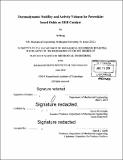Thermodynamic stability and activity volcano for perovskite-based oxide as OER catalyst
Author(s)
Rong, Xi, Ph. D. Massachusetts Institute of Technology
DownloadFull printable version (7.344Mb)
Other Contributors
Massachusetts Institute of Technology. Department of Mechanical Engineering.
Advisor
Alexie M. Kolpak.
Terms of use
Metadata
Show full item recordAbstract
Design of efficient and cost-effective catalysts for the oxygen evolution reaction (OER) is crucial for the development of electrochemical conversion technologies. Recent experiments show that perovskite transition-metal oxides can exhibit high electro-catalytic activity for OER. Both binding strength of reaction intermediate and [sigma]*-antibonding (eg) orbital filling of transition-metal ions in the clean surface prove to be descriptors of perovksite activity. Plotting of activity vs. a descriptor gives a volcano curve. However, little is known about the thermodynamic stability and the catalytic activity of perovskite surface reconstructions. Reconstructions such as defect, adsorbate, and steps are widely detected in experiments. They are caused by realistic environment during fabrication, measurement, and eventual device operation. In this work, we apply first-principles density functional theory and ab initio electro-thermodynamics to investigate the environment-dependent surface reconstructions of perovskite, particularly those based on LaMnO 3. We develop a surface stability phase diagram as a function of pH and electrode potential, and compare those catalytic activities under realistic liquid environment of electrolysis device. Our results show that values of pH and electrode potential can greatly affect surface structure and its activity. The new approach developed in this work is applicable to other oxide catalysts.
Description
Thesis: S.M., Massachusetts Institute of Technology, Department of Mechanical Engineering, 2014. Cataloged from PDF version of thesis. Includes bibliographical references (pages 55-58).
Date issued
2014Department
Massachusetts Institute of Technology. Department of Mechanical EngineeringPublisher
Massachusetts Institute of Technology
Keywords
Mechanical Engineering.